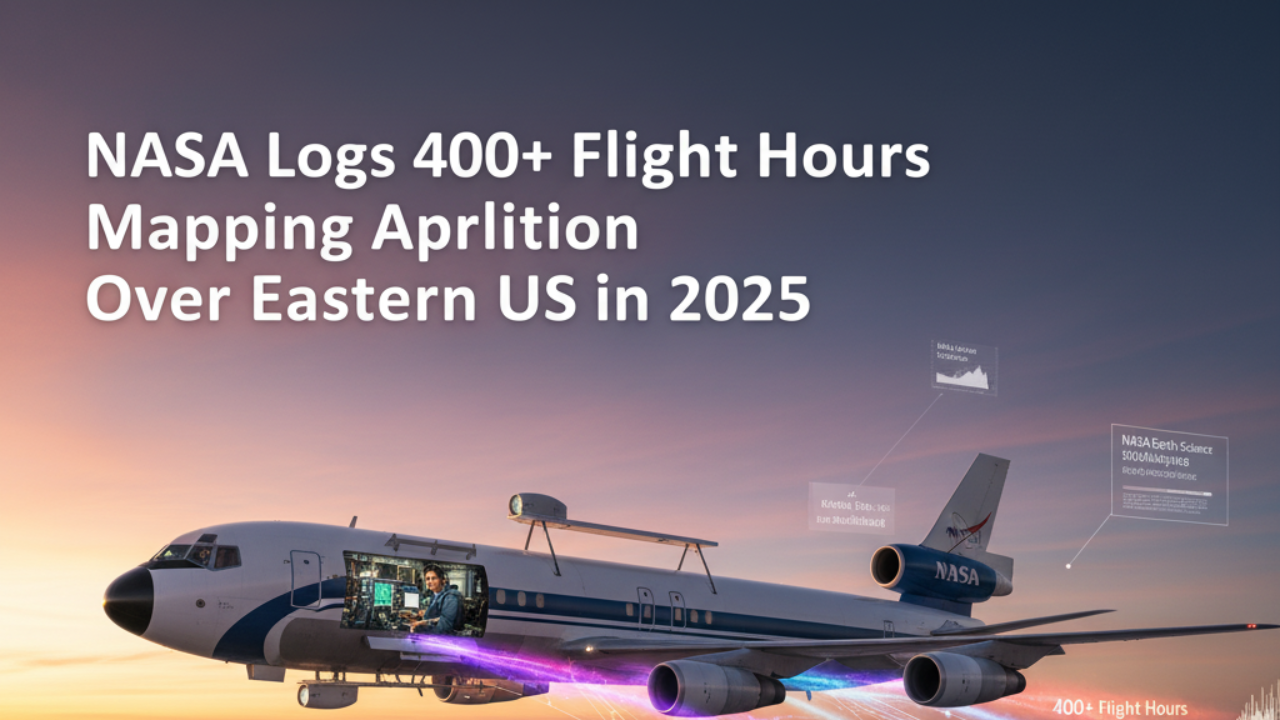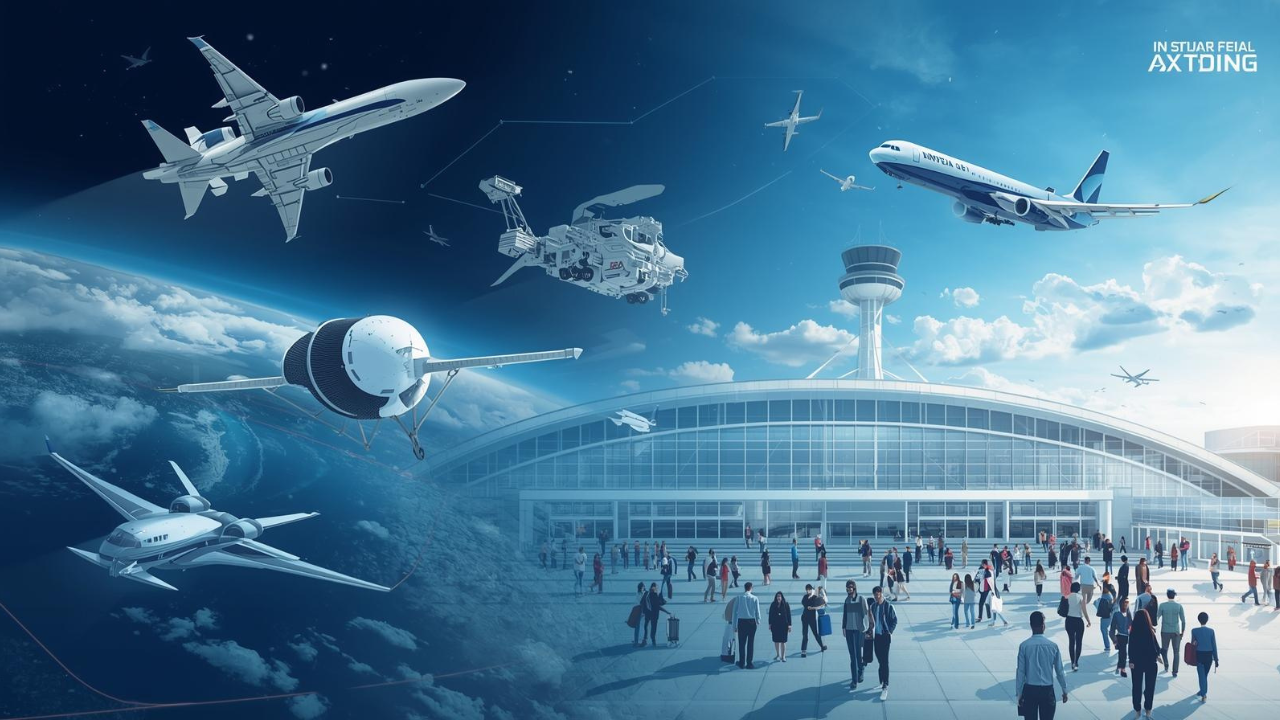
Post by : Shivani
In a high-flying quest to demystify the invisible threat of air pollution, NASA's 2025 airborne campaign soared through the skies over the mid-Atlantic United States, logging more than 400 collective flight hours across six specialized aircraft. Launched as part of the Synergistic TEMPO Air Quality Science (STAQS) and related initiatives, this summer-long endeavor—spanning June to September—targeted urban megacities, industrial corridors, and wildfire-prone regions to create unprecedented 3D maps of pollutants like nitrogen dioxide (NO2), ozone (O3), and particulate matter. By validating data from NASA's geostationary TEMPO satellite, the mission equips policymakers with granular insights to curb emissions, enhance public health, and combat climate change.
NASA's Goddard Space Flight Center spearheaded the effort, coordinating flights from bases in Virginia and Maryland. "This data will directly inform air quality regulations and climate strategies, turning satellite observations into actionable intelligence," said Glenn Wolfe, principal investigator at Goddard. [] As urban populations swell and wildfires intensify, these flights—flying as low as 1,000 feet over hotspots like Baltimore, Philadelphia, and Norfolk—reveal how pollutants evolve hourly and spatially, far beyond ground monitors' reach.
The 2025 campaign built on prior years' successes, expanding to six aircraft for multifaceted data collection. NASA's P-3 Orion, a four-engine workhorse from Wallops Flight Facility, led with remote sensing of tropospheric composition, while the King Air B200 buzzed urban plumes at low altitudes. Complementing them were NOAA's Twin Otter for in-situ sampling, a DC-8 for high-altitude overviews, and specialized drones for forestry-fire interfaces.
Flights crisscrossed the Eastern Seaboard, focusing on emission sources: power plants in Hopewell, Virginia; landfills near Richmond; and traffic-choked corridors in the I-95 corridor. Over 100 sorties captured diurnal cycles—morning rush-hour spikes to evening industrial surges—aligning with TEMPO's hourly scans from 22,000 miles up. Ground teams launched weather balloons and mobile labs in economically disadvantaged neighborhoods, ensuring equitable data coverage.
Key to the mission's success was integration with commercial satellites like those from Planet Labs, cross-verifying pollution plumes down to 4-square-mile resolutions. Early results highlight NO2 hotspots over Philadelphia's refineries, where levels exceed EPA standards by 25% during peak hours, underscoring the need for targeted interventions.
| Aircraft | Operator | Altitude Range | Primary Instruments | Flight Hours (Est.) |
|---|---|---|---|---|
| P-3 Orion | NASA Wallops | 1,000–28,000 ft | Remote sensing spectrometers (NO2, O3) | 150+ |
| King Air B200 | Dynamic Aviation/NASA | 1,000–10,000 ft | In-situ gas analyzers, lidar | 100+ |
| Twin Otter | NOAA | 500–15,000 ft | Aerosol samplers, VOC detectors | 80+ |
| DC-8 | NASA Armstrong | 20,000–41,000 ft | High-alt. radiometers, trace gas profilers | 50+ |
| Drones (sUAS) | University Partners | Surface–2,000 ft | PM2.5 sensors, thermal imaging | 20+ |
| Total | - | - | - | 400+ |
At heart, the flights measured tropospheric column densities—total molecules per square centimeter of NO2, a fossil fuel combustion byproduct central to ozone and PM2.5 formation. Instruments like the Geostationary Trace Gas and Aerosol Sensor (GTGAS) on the P-3 detected plumes from wildfires in the Appalachians, which spiked Eastern ozone by 15% in July 2025.
Volatile organic compounds (VOCs) from landfills and benzene from refineries were sampled in real-time, revealing "fugitive emissions" evading ground detection. In Baltimore's industrial zones, flights identified a 30% underreporting in NO2 from shipping ports, informing EPA revisions. Aerosol lidar mapped particulate layers, linking them to health disparities in communities of color, where asthma rates are 40% higher.
Beyond air quality, the data feeds forestry management: Flights over Virginia's forests quantified biogenic VOCs interacting with anthropogenic pollution, exacerbating ground-level ozone. Fire management benefited from thermal imaging of smoldering hotspots, preventing escalation during a record-dry summer.
The mission's revelations are already rippling outward. In Philadelphia, flight data corroborated TEMPO's detection of a 20% NO2 surge during heatwaves, prompting citywide electric bus incentives. Norfolk's port emissions mapping supports a $500 million federal grant for green infrastructure, reducing PM2.5 exposure for 200,000 residents.
Equity is paramount: Flights prioritized "environmental justice" areas, like Hopewell's chemical plants, where legacy pollution burdens low-income families. "Every community deserves clean air—this mission maps the path to justice," noted John Sullivan, STAQS ground operations lead. Health agencies project a 10–15% drop in respiratory illnesses if policies leverage this data.
Climate ties are profound: NO2 and methane measurements from landfills contribute to warming models, aligning with US net-zero goals by 2050. The dataset, publicly released in October 2025, empowers 400+ early adopters, from state DEPs to NGOs.
TEMPO, launched in 2023 on Intelsat 40e, provides hourly NO2 maps across North America at 2.1 km resolution— a leap from polar-orbiters' daily glimpses. The 2025 flights calibrated its algorithms against in-situ truths, boosting accuracy by 20% for urban plumes.
Global echoes: TEMPO joins South Korea's GEMS and ESA's Sentinel-4, forming a hemispheric pollution watch. Future missions eye 2026 expansions to the Midwest, incorporating AI for plume forecasting.
Logistics tested the team: Summer thunderstorms grounded flights 15% of days, and low-altitude ops demanded FAA waivers. Yet, student pilots from HBCUs logged 50 hours, fostering diverse talent pipelines. Data volume—terabytes of spectra—required cloud processing at Goddard, yielding interactive dashboards by fall.
On X, excitement buzzed: @NASAGoddard shared plume visuals, garnering 50K likes, while #TEMPO2025 trended with posts like "From skies to policy—NASA's fighting invisible foes!" Critics noted gaps in Southern coverage, but experts hail it as "game-changing.
2025's 400+ flight hours aren't just data—they're a blueprint for breathable futures. As Eastern US cities leverage these maps for emission cuts, NASA's campaign underscores science's role in equity and sustainability. With TEMPO's vigilant eye and aircraft's precision, the path from pollution to policy is clearer than ever. The air may be invisible, but its transformation is within reach.
Explore More: Dive into datasets at tempo.si.edu or follow @NASAEarth for updates. Track real-time NO2 via TEMPO's live maps.
#NASA #AirPollution #TEMPO #STAQS #CleanAir #AirQuality #EasternUS #PollutionMapping #ClimateAction #NASAFlights










Advances in Aerospace Technology and Commercial Aviation Recovery
Insights into breakthrough aerospace technologies and commercial aviation’s recovery amid 2025 chall

Defense Modernization and Strategic Spending Trends
Explore key trends in global defense modernization and strategic military spending shaping 2025 secu

Tens of Thousands Protest in Serbia on Anniversary of Deadly Roof Collapse
Tens of thousands in Novi Sad mark a year since a deadly station roof collapse that killed 16, prote

Canada PM Carney Apologizes to Trump Over Controversial Reagan Anti-Tariff Ad
Canadian PM Mark Carney apologized to President Trump over an Ontario anti-tariff ad quoting Reagan,

The ad that stirred a hornets nest, and made Canadian PM Carney say sorry to Trump
Canadian PM Mark Carney apologizes to US President Trump after a tariff-related ad causes diplomatic

Bengaluru-Mumbai Superfast Train Approved After 30-Year Wait
Railways approves new superfast train connecting Bengaluru and Mumbai, ending a 30-year demand, easi